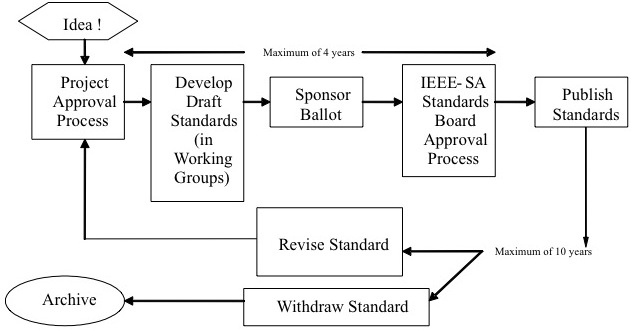How Are Standards Made?
The process of developing a standard is typically facilitated by a Standards Development Organization (SDO), which adheres to fair and equitable processes that ensure the highest quality outputs and reinforce the market relevance of standards. SDOs, such as IEEE, IEC, ISO, and others, offer time-tested platforms, rules, governance, methodologies and even facilitation services that objectively address the standards development lifecycle, and help facilitate the development, distribution and maintenance of standards.
While the goals of each SDO are essentially the same, each SDO applies its own rules, processes, and terminology to the standards development process. Typically, each SDO is comprised of Boards, Committees and staff who establish and maintain the policies, procedures and guidelines that help ensure the integrity of the standards development process, and the standards that are generated as an outcome of this process.
The development of a new standard is typically triggered by a formal request, submitted to an SDO by a managing body (individual or entity, such as an industry society) for review and evaluation. The SDO mandates, oversees, and helps facilitate the process for standards development. The Standards Committee for the project assumes responsibility for the respective area of standards development, including the organization of the standards development team and its activities.
Once the SDO approves the request to develop a new standards development project, the sponsor follows the SDOs rules and processes to recruit and assemble a collaborative team or “Working Group” to engage in active standards development. (Note: The term “Working Group” is an IEEE term. Working Groups may be called different names by the various SDOs, and may follow slightly different processes). Working Groups are comprised of individuals and/or entities (people, companies, organizations, non-profits, government agencies) who volunteer to support the development of standards.
Collectively, these volunteer participants carry a specific interest in a specific area of development as producers, sellers, buyers, users and/or regulators of a particular material, product, process or service. When a Working Group is formed the Working Group officers may either be elected by the Working Group members or appointed by the Sponsor. Consult the Sponsor’s Policies and Procedures and the Sponsor’s Working Group Policies and Procedures for details. Working Group officers oversee the standards development project in adherence to SDO rules and process, and remain accountable to the project Sponsor and the governance structure of the SDO itself.
Based on the rules and criteria established by the SDO, participants may contribute at varying levels to the standards development process. For example, the IEEE Standards Association (IEEE SA) has established rules related to membership and participation, and employs a separate “Entity Standards Development Process” for standards that are sponsored by entities (such as corporations, governments, non-profits, associations or other organizations, etc.). Such rules help ensure that highly dedicated individuals lead participation and no one interest dominates the standards development process. Working Groups leverage these rules and guidelines and establish their own individual, organizational, communications and meeting structures, and govern work process, activities, consensus building, decision making, balloting and even financial reporting in accordance with SDO rules. To build consensus through democratic means, participants engage in meetings, draft and review position pieces, create and review presentations, examine data and engage in active discussion and debate to resolve outstanding issues.
These activities fuel the gradual definition of each standard, which is compiled into a draft standard that may undergo multiple revisions. Within the IEEE SA, once a draft standard has been finalized, reviewed, and approved by the Working Group, it is submitted to the Standards Committee for the SA Ballot. Upon successful completion of the SA Ballot, the draft is submitted to the Review Committee (RevCom). The balloted draft is reviewed by RevCom and then submitted to the Standards Board for approval. After submission, review and acceptance, the approved standard is published and made available for distribution and purchasing within in a number of outlets, including through the SDO itself.
It is important to remember that standards are “living documents”, which may initially be published and iteratively modified, corrected, adjusted and/or updated based on market conditions and other factors. At any given point in time, therefore, a standard may be referred to as having a number of different “status” classifications. Within IEEE, these include:
- Approved Project – An initial project request is approved, in stages of group formation.
- Active Project – An active standards development project.
- Withdrawn Project – A cancelled standards development project.
- Approved Standard – The standard is approved and published for public use.
- Withdrawn Standard – The standard is no longer market relevant or active.
- Superseded Standard – The standard has been replaced by a new standard.
In keeping with the standards development lifecycle, Working Groups may also go through periodic stages of activity or dormancy. Depending on where a standard is in its lifecycle a standard may be accompanied by supplemental documents that are produced by its respective Working Group. These may include errata (which address errors in the standard), amendments (which modify sections of the standard), corrigenda (which only correct errors or ambiguities in a standard), handbooks, tutorials and other related materials. Supplemental documents help interested parties better understand and apply the standard.
Figure 1 – Overview


